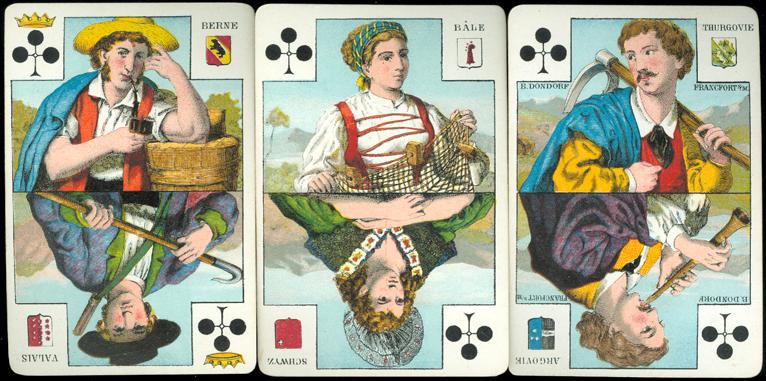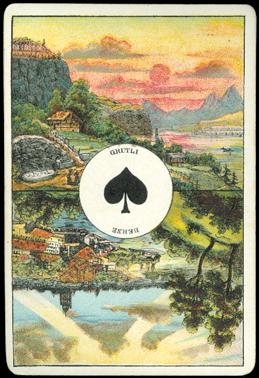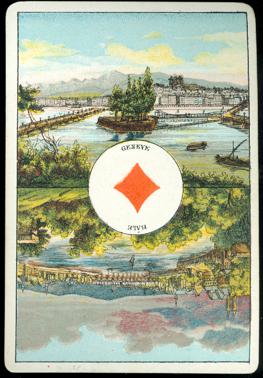April 2012
After April 27 we
had to sit it out until "Queen's Day", when we celebrate the
birthday of our Queen in the Netherlands and everywhere people sell their stuff
on the streets. We already knew which deck would be shown
here, but there's always a possibility -be it an extremely minimal one- that something great
will be found on that last day of April. It was a lovely day with lots of sun
and fun,
but -as expected- no super find.
|
Mid April there
was the largest collectors fair in the Jaarbeurs in Utrecht and once again it
was Miriam who found a very rare deck. It's an early Dutch football quartet by the
Speelkaartenfabriek Nederland, which was still missing in our SN collection.
So....within a few hours our weekend was already made! We did find some other
nice decks there, but nothing really special. Although we consider this quartet
deck our best find, we don't show it here, because this site is dedicated to
suited playing cards only. So for this page our deck had to come from elsewhere
again. |
 |
We had 2 bids in the 52+ auction, but neither was a winner. |

|
|
On the 22nd the
Dutch playing cards collectors meeting was held in Nieuwerbrug, but it was a bit
disappointing to see that -although it was the 50st meeting- again there were
less attendants and visitors than at the previous meeting. Trading was very slow
and it didn't bring any good finds either. So the internet had to supply our winner here. We had done well selling on eBay
and didn't really get a chance to spend this money during the above events, so
we spent it on eBay and the Dutch auction site. |
We added a good
number of decks again and there was an interesting shortlist until the 27th.
When we received this deck, the decision was immediately taken. Of course this
deck is an antique and rarely seen one, but that wasn't what tipped the scale.
In this case the skies did it and we're happy to show the deck here and tell you
why.
The deck was
printed in chromolithography by Bernard Dondorf from Francfort s/M (see the
Jack of Clubs) and it was published from around 1868 until around 1885 as "Vues
et caractères Suisses" (Nr. 228). It was probably made for export to the
Swiss market and not for the domestic German market. The used language in the
deck is French. Names of towns and cities from the French speaking part of
Switzerland are given in French and also the reference to the maker's own town
is in French: s/M = sur Main. In German it would have been a/M (am Main).

The courts each
show two Swiss "characters". The name of the canton (Swiss provence), that
they represent is mentioned in the right corner, together with its coat of arms. In the left corner there's the suit sign and on the Kings a crown is
added there. That's not superfluous, because the figures depict common
people and are not recognizable as royalty. If the crown hadn't been added in
the Hearts suit here below, it would have been impossible to tell the King from
the Jack.

As said, the skies
tipped the scale for this deck. Not the bright blue skies on the courts,
suggesting a beautiful summer day, but rather the skies on the aces did the job.
We have quite a few decks with illustrated aces, but have never seen skies
like these on any of them. There's a full moon
over Interlaken, it's dawning in Zurich and the sun is setting over Grutli. Each
view is crowned with a delightful sky, showing a different time of the day and
even of the season.




The views not only
show the main Swiss cities Genève, Bale, Berne, Zurich, Schafhouse and
Interlaken, but also the rather unknown Engelberg and Grutli (French for Rütli). The latter is a
mountain meadow on lake Lucerne that has played an important role in Swiss
history and from around 1850 Engelberg became a well-known international
vacation resort and spa. So their appearance on these aces is not
coincidental.

It may seem that some
cantons were considered more important than others, as some regions are represented on two cards. Berne (Bern) is on the
King of Clubs and the Queen of Hearts, Bale (Basel) on the Queen of Clubs and
the King of Hearts, Lucerne (Luzern) on the King of Diamonds and the Queen of
Hearts, Appenzell on the King of Hearts and the Queen of Diamonds and Fribourg (Freiburg)
on the King and Queen of Diamonds, while Genève (Geneva) is only mentioned once.

The deck consists
of 52 cards. The back design shows Helvetia. The allegory is typically pictured
in a flowing gown, with a spear and a shield emblazoned with the Swiss flag, and
commonly with braided hair and a wreath as a symbol of confederation. Here she's
depicted with a chamois and a hat that masks the spear: definitely a more
friendly and idyllic Helvetia. The maker's name and town are mentioned at the
bottom.

Unfortunately our
deck didn't come with a box, but..... sometimes you can't have it all.
BACK TO PRESENT MONTH










